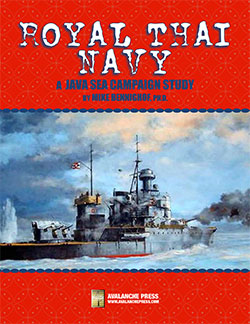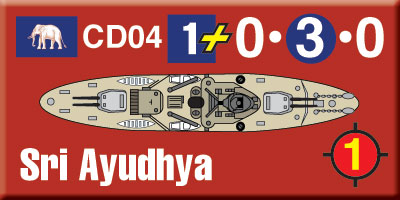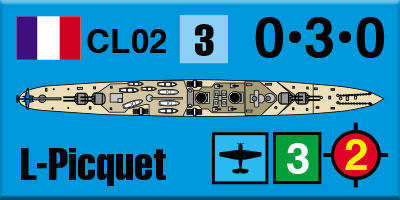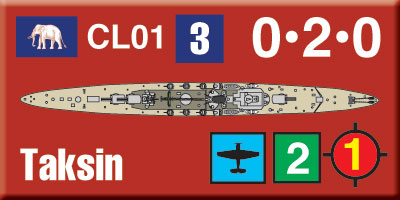| Java Sea: Royal Thai Navy
Scenarios & History
by Mike Bennighof, Ph.D.
June 2024
 When I sketched out the parameters of Second World War at Sea: Java Sea, I knew that I wanted to include the brief Franco-Thai naval war of early 1941. It’s a little-known conflict, that took place in what was at the time of backwater of the Second World War at sea. But I wrote too much material for Java Sea, and couldn’t fit everything I wished into the scenario book. And thus was born the Campaign Study, Royal Thai Navy. When I sketched out the parameters of Second World War at Sea: Java Sea, I knew that I wanted to include the brief Franco-Thai naval war of early 1941. It’s a little-known conflict, that took place in what was at the time of backwater of the Second World War at sea. But I wrote too much material for Java Sea, and couldn’t fit everything I wished into the scenario book. And thus was born the Campaign Study, Royal Thai Navy.
Royal Thai Navy is centered around the chapter left over from Java Sea, based on the brief naval campaign of the Franco-Thai War and the Battle of Koh-Chang Roads that resulted from it. It’s a Campaign Study, what we call our small books of scenarios and history that explore some additional aspect of our games.
The Royal Thai Navy was not very big; its major units were a pair of coast-defense ships and two armored gunboats. Two light cruisers ordered from an Italian shipyard never arrived, but we have pieces for them in Java Sea, too. They also had some very small modern torpedo boats, four small coastal submarines, and a few ancient warships that played no role in the Franco-Thai conflict. They did, however, have a fairly large and modern air force for a minor power.

Their French enemies fielded an even weaker naval force, built around the two-decade-old light cruiser Lamotte-Picquet. Supporting her, the French could count on two modern but slow and weakly-armed colonial sloops, designed as a cost-effective means of showing the flag in distant waters and conducting hydrographic surveys. They also had some aged gunboats, including a river gunboat sent to sea, but no submarines and next-to-no aircraft.
Royal Thai Navy doesn’t split its scenarios into formal chapters, because I had plenty of historical material regarding the campaign, the battle and the Royal Thai Navy that I wanted included in the book, so we present the scenarios all in one chapter (this kept us from having to leave any of them out, which I would have found painful).
The first segment is all about the Franco-Thai campaign. The Thais are using their small fleet to support an advance on land into French-ruled Cambodia, but not very aggressively. Each night they take their ships to Koh-Chang Roads, an astonishingly beautiful little group of islands with an undefended and almost unimproved anchorage (a small radio station, but no other naval facilities). One coast-defense ship usually undertook the “support” mission supported by a couple of orpedo boats, to be relieved by the other every few days.
In the actual event, the French steamed right up to the anchorage and kicked the Thais’ asses. They neutralized the torpedo boats quickly, which did not get off any torpedoes, and shot up the coast-defense ship, which eventually sank.
That’s the historical operational scenario, and the first battle scenario. The coast-defense ship did no damage to the French cruiser (which is going to do most of the heavy lifting); but she certainly had the armament (four 7.9-inch, not 8-inch, guns) to do so. It’s a quick-playing scenario, in which the Thais can hide behind the islets that rim the anchorage and look for their shot against the cruiser.

In the operational scenario, there’s no guarantee that the French will be greeted by such a perfect alignment. Both coast-defense ships might be at the anchorage, or the French can try to intercept them at sea, where the wallowing tubs can’t hope to escape the cruiser. But they do have bigger guns than the French, even if they’re not as adept at using them.
With Royal Thai Navy, I wanted to explore more than the brief Franco-Thai naval war. The next scenario segment leaves the Thais aside and looks at the French. In the days after the British attack on their erstwhile French allies at Mers-el-Kebir in Algeria, they also threatened the small French squadron in Indochina. The French leaders had hoped to win the support of the British against Japanese encroachment on the colony, but Sir Percy Noble of the China Station passed on an ultimatum instead: rally to the Free French movement, or face British attack.
The threat actually happened, but it would not be carried out. The China Station had fielded a mid-sized fleet when the war began, but these ships had steadily been drawn away. By July 1940, Sir Percy’s intimidation consisted of three aged D-class light cruisers of Great War vintage, and two equally-vintage destroyers.
Even though this little naval war never happened, we have a scenario for it. The British can put pressure on the French through commerce raiding, and of course through destroying French warships. The French can strike back against British commerce. We also have a battle scenario; the French are out-numbered but their one cruiser is a much better warship than the British ships. She’s still not good, mind you; the British are that much worse.
By September 1941, though, Lamotte-Picquet showed the effects of years without maintenance. Saigon’s Naval Yard could not drydock her, and the French authorities made arrangements for the work to be performed in Osaka, Japan. British naval intelligence picked up on this move, and interpreted it as a planned breakout in which the cruiser would make for Europe. The China Station deployed its tiny fleet to hunt for her.

That part is what happened; afterwards, Lamotte-Picquet slogged her way to Japan for badly-needed boiler and hull repairs. The British found nothing. But we do get to play out a French breakout, as if the cruiser had her full speed and her commander Régis Bérenger a suicidal bent. It’s a cat-and-mouse game, but the geography of the Indonesian archipelago gives the French ship only a limited number of ways home. Then we get a battle scenario so they can fight it out.
But the book is called Royal Thai Navy, so we need to return to the king’s tiny fleet. Japan invaded Thailand in December 1941, fighting the Thais rather than including them in their schemes. While the Thai national police fought the invaders, and parts of the army, the tiny fleet remained at its base at Sittahip and watched the Japanese steam past on their way to Bangkok.
While the Thais are not very strong, neither is the Japanese escort force – the Japanese spread themselves thin in their audacious attempt to seize many objectives at once. The Thais know exactly where the Japanese must go, and their little fleet only has to face a Japanese cruiser and some aged destroyers. It’s still going to be a tough fight.
Thailand also had beef with the British, who seized a slice of the kingdom bordering Malaya in 1909. That would lead the Thais to form an alliance with Japan in January, but the Japanese could easily have inked that agreement a month earlier and had free access to Thai territory and the dubious aid of the Thai fleet and air force.
That greatly changes the situation in December 1941; the Japanese forces that invaded Thailand are available to strike Malaya, and perhaps more importantly, they can place air units in Thailand right on the Malayan border. The Thai fleet is there to help, and we’ve included the two Italian-built cruisers as well.
In the historical event, the Japanese kept the Thais out of the loop to maintain operational security, so in our scenario, the British know that the Japanese-Thai Axis is coming. The restrictions on British force seen in the historical scenarios in the Java Sea game are relaxed here; the Thai fleet probably isn’t enough added strength to offset that. But we do get a battle between Thai and British cruisers, which is something you don’t play every day.
Royal Thai Navy meets what I consider the perfect ratio between story and scenario; exactly half of the book is devoted to the history and the fleet, and the other half to scenarios. They play much more quickly than those in the core game, Java Sea, because the fleets just aren’t nearly as large. It was satisfying to write, and I think you’ll like it.
You can order Royal Thai Navy right here.
You can order Java Sea right here.
Naval Campaigns
Java Sea: Royal Thai Navy
Java Sea: Wicked Sisters
Coral Sea: Defending Australia
Midway: Rising Sun 1940
Gulf of Aden
Retail Price: $64.95
Package Price: $50.00
Gold Club Price: $40.00
You can order Naval Campaigns right here.
Sign up for our newsletter right here. Your info will never be sold or transferred; we'll just use it to update you on new games and new offers.
Mike Bennighof is president of Avalanche Press and holds a doctorate in history from Emory University. A Fulbright Scholar and NASA Journalist in Space finalist, he has published a great many books, games and articles on historical subjects; people are saying that some of them are actually good.
He lives in Birmingham, Alabama with his wife, three children, and new puppy. He misses his lizard-hunting Iron Dog, Leopold.
Want to keep Daily Content free of third-party ads? You can send us some love (and cash) through this link right here.
|
